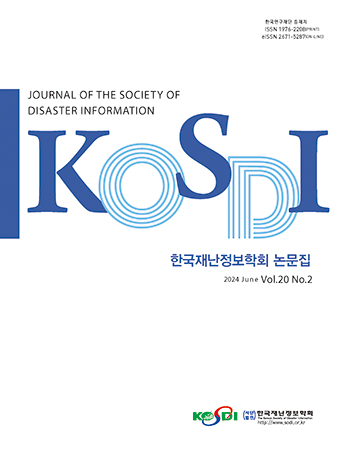Original Article
Abstract
References
Information
Purpose: This study conducted research on the sharing of information to enhance the survival rate of emergency patients by swiftly transferring them to appropriate hospitals through sharing the patients' conditions, treatment histories, and transportation information with the Maritime Police Agency and relevant agencies when emergencies occur in the marine environment. Methods: In this study, emergency patient information classified in a smartphone app was received, stored, and transmitted using the LoRa communication method by electronic triage tags, and the transmitted emergency patient information was implemented to be collected in real-time through a hybrid triage system along with LoRa receivers. Results: Through the hybrid triage system, it was possible to receive emergency patient information according to the distance or confirm delayed reception. It was observed that most data were received when the distance was short, while data reception was unsuccessful in relatively longer distances. Conclusion: It was confirmed that in mass disaster environments where internet communication is impossible, rapid and accurate understanding of casualty information at disaster sites and appropriate disaster responses can be achieved using self-networking methods such as LoRa communication. However, limitations inherent in communication methods were also recognized. Further research on various communication methods is required to collect emergency patient information and transfer them to appropriate hospitals in situations where internet communication is unavailable.
연구목적: 본 연구는 해양 환경에서 응급환자 발생시 환자의 상태, 처치내역, 이송정보 등을 해양경찰청 및 유관기관과 공유하여 적정이송병원으로 신속하게 이송함으로써 응급환자의 생존율을 향상시키기 위한 정보공유 방안에 관한 연구를 진행하였다. 연구방법: 본 연구에서는 LoRa 통신 방식을 활용하여 전자 트리아지 태그가 스마트폰 앱에서 분류된 응급환자 정보를 수신하여 저장하고 송신하며, 송신된 응급환자 정보는 LoRa 수신기와 함께 하이브리드 트리아지 시스템을 통해 실시간 수집할 수 있도록 구현하였다. 연구결과: 하이브리드 트리아지 시스템을 통해 거리에 따라 응급환자 정보를 수신하거나 지연된 수신을 확인할 수 있었다. 거리가 가까운 경우 대부분의 데이터가 수신되었고, 비교적 거리가 먼 경우 데이터가 수신되지 못하는 것을 확인 하였다. 결론: 대량 재난 환경에서 인터넷 통신이 불가능할 경우 LoRa 통신 등 자가망을 이용하여 재난 현장의 사상자 정보를 신속하고 정확하게 파악하여 적절한 재난 대응을 할 수 있음을 확인할 수 있었다. 다만, 통신 방식의 특성에 따은 한계점 또한 인식하였다. 향후 다양한 통신방식에 대한 연구를 통해 인터넷 통신이 불가능한 상황에서 응급환자 정보를 수집하고 적절한 병원으로 이송할 수 있도록 하는 추가 연구가 요구된다.
- Aslam, S., Michaelides, M.P., Herodotou, H. (2020). "Internet of ships: A survey on architectures, emerging applications, and challenges." IEEE Internet of Things Journal, Vol. 7, No. 10, pp. 9714-9727. 10.1109/JIOT.2020.2993411
- Han, J., Kim, K., Lee, W., Park, K. (2023). "Reviewing the operation of the navy safety management system and its direction." Journal of the Society of Disaster Information" Vol. 19, No. 4, pp. 859-868.
- Jo, S.-W., Shim, W.-S. (2019). "LTE-maritime: High-speed maritime wireless communication based on LTE technology." IEEE Access, Vol. 7, pp. 53 172-53 181. 10.1109/ACCESS.2019.2912392
- Messelink, D.M., van der Ploeg, G.-J., van der Linden, T., Flameling, R.D., Bierens, J.J.L.M. (2023). "Medical emergencies at sea: an analysis of ambulance-supported and autonomously performed operations by lifeboat crews." BMC Emergency Medicine, Vol. 23, 108. 10.1186/s12873-023-00879-7 37726714 PMC10510182
- Park, B., Cho, N. (2023). "Reinforcement learning model for mass casualty triage taking into account the medical capability." Journal of the Society of Disaster Information, Vol. 19, No. 1, pp. 44-59.
- Wei, T., Feng, W., Chen, Y., Wang, C.-X., Ge, N., Lu, J. (2021). "Hybrid satellite-terrestrial communication networks for the maritime internet of things: Key technologies, opportunities, and challenges." IEEE Internet of Things Journal, Vol. 8, No. 11, pp. 8910-8934. 10.1109/JIOT.2021.3056091
- Yang, T., Shen, X.S. (2014). Maritime Wideband Communication Networks. Springer, USA. 10.1007/978-3-319-07362-0
- Publisher :The Korean Society of Disaster Information
- Publisher(Ko) :한국재난정보학회
- Journal Title :Journal of the Society of Disaster Information
- Journal Title(Ko) :한국재난정보학회논문집
- Volume : 20
- No :1
- Pages :206-212
- DOI :https://doi.org/10.15683/kosdi.2024.3.31.206




 Journal of the Society of Disaster Information
Journal of the Society of Disaster Information







